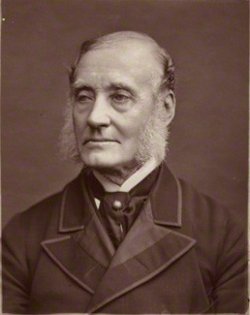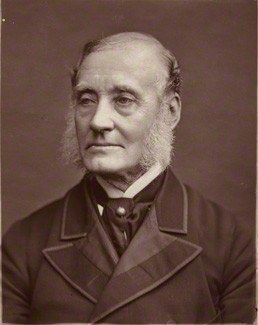Sir Rutherford Alcock, KCB (May 1809 - 2 November 1897) was the first British diplomatic representative to live in Japan.
Early life
Alcock was the son of the physician, Dr. Thomas Alcock, who practised at Ealing, near London. He was named John Rutherford Alcock, but dropped the John very early. As he grew up, Alcock followed his father into the medical profession. In 1836, he became a surgeon in the marine brigade which took part in the Carlist War, gaining distinction through his services. Alcock was made deputy inspector-general of hospitals. He retired from this service in 1837.
Service in China
In 1844, he was appointed consul at Fuchow in China, where, after a short official stay at Amoy, he performed the functions, as he expressed it, "of everything from a lord chancellor to a sheriff's officer." Fuchow was one of the ports opened to trade by the Treaty of Nanking, and Alcock had to perform an entirely new role with regard to the Chinese authorities. In doing so, he earned a promotion to the consulate at Shanghai. He worked there until 1846 and made it a special part of his duties to superintend the established Chinese government and lay out the British settlement, which had developed into such an important feature of British commercial life in China.
Service in Japan (1858-64)
In 1858, he was appointed Consul-General in Japan. Alcock opened the first British legation in Japan within the grounds of Tôzen-ji in Takanawa, Edo (now Tokyo). He saw "peace, plenty, apparent content, and a country more perfectly cultivated and kept, with more ornamental timber everywhere, than can be matched even in England."
In those days, foreign residents in Japan faced some danger, with noticeable Japanese hostility to foreigners (sonnô jôi). In 1860, Alcock's native interpreter was murdered at the gate of the legation, and in the following year the legation was stormed by a group of ronin from the fiefdom of Mito Han, whose attack was repulsed by Alcock and his staff.
In 1860 he became the first non-Japanese to climb Mount Fuji.
Service in China (1865-69)
Shortly after these events he returned to England on leave on March 1862, and was replaced in Japan by Colonel Neale. Alcock had already been made a Commander of the Bath (CB) (1860). In 1862 he was made a Knight of the same order (KCB), and in 1863 received an honorary Doctorate of Laws from Oxford University.
In 1864, he returned to Japan, and after a year's further residence he was transferred to Peking, where he represented the British government until 1869, when he retired.
Later years
Although no longer in official life, he remained active. He was for some years president of the Royal Geographical Society, and he served on many commissions. The official Japanese section at the 1862 International Exhibition in London was prepared by Sir Rutherford and included his own collection. This is considered one of the most important events in the history of Japanese art in the West and a founding date for English Japonism in the decorative arts, the Anglo-Japanese style. From 1882-93 he was chairman of the British North Borneo Chartered Company.
He was twice married, first in May 1841 to Henrietta Mary Bacon (daughter of Charles Bacon), who died in 1853, and second (on 8 July 1862) to the widow of the Rev. John Lowder. His second wife died on 13 March 1899.
Alcock was the author of several works, and was one of the first to awaken in England an interest in Japanese art. He tried hard to learn the language and even wrote a text book. His best-known book is The Capital of the Tycoon, which appeared in 1863. He died in London on 2 November 1897, and is buried at Merstham in Surrey.
Sir Rutherford was buried at Merstham on 6 November 1897. He was the husband of Lucy Lowder nee Windsor, the widow of the Reverend John Lowder.
Sir Rutherford Alcock, KCB (May 1809 - 2 November 1897) was the first British diplomatic representative to live in Japan.
Early life
Alcock was the son of the physician, Dr. Thomas Alcock, who practised at Ealing, near London. He was named John Rutherford Alcock, but dropped the John very early. As he grew up, Alcock followed his father into the medical profession. In 1836, he became a surgeon in the marine brigade which took part in the Carlist War, gaining distinction through his services. Alcock was made deputy inspector-general of hospitals. He retired from this service in 1837.
Service in China
In 1844, he was appointed consul at Fuchow in China, where, after a short official stay at Amoy, he performed the functions, as he expressed it, "of everything from a lord chancellor to a sheriff's officer." Fuchow was one of the ports opened to trade by the Treaty of Nanking, and Alcock had to perform an entirely new role with regard to the Chinese authorities. In doing so, he earned a promotion to the consulate at Shanghai. He worked there until 1846 and made it a special part of his duties to superintend the established Chinese government and lay out the British settlement, which had developed into such an important feature of British commercial life in China.
Service in Japan (1858-64)
In 1858, he was appointed Consul-General in Japan. Alcock opened the first British legation in Japan within the grounds of Tôzen-ji in Takanawa, Edo (now Tokyo). He saw "peace, plenty, apparent content, and a country more perfectly cultivated and kept, with more ornamental timber everywhere, than can be matched even in England."
In those days, foreign residents in Japan faced some danger, with noticeable Japanese hostility to foreigners (sonnô jôi). In 1860, Alcock's native interpreter was murdered at the gate of the legation, and in the following year the legation was stormed by a group of ronin from the fiefdom of Mito Han, whose attack was repulsed by Alcock and his staff.
In 1860 he became the first non-Japanese to climb Mount Fuji.
Service in China (1865-69)
Shortly after these events he returned to England on leave on March 1862, and was replaced in Japan by Colonel Neale. Alcock had already been made a Commander of the Bath (CB) (1860). In 1862 he was made a Knight of the same order (KCB), and in 1863 received an honorary Doctorate of Laws from Oxford University.
In 1864, he returned to Japan, and after a year's further residence he was transferred to Peking, where he represented the British government until 1869, when he retired.
Later years
Although no longer in official life, he remained active. He was for some years president of the Royal Geographical Society, and he served on many commissions. The official Japanese section at the 1862 International Exhibition in London was prepared by Sir Rutherford and included his own collection. This is considered one of the most important events in the history of Japanese art in the West and a founding date for English Japonism in the decorative arts, the Anglo-Japanese style. From 1882-93 he was chairman of the British North Borneo Chartered Company.
He was twice married, first in May 1841 to Henrietta Mary Bacon (daughter of Charles Bacon), who died in 1853, and second (on 8 July 1862) to the widow of the Rev. John Lowder. His second wife died on 13 March 1899.
Alcock was the author of several works, and was one of the first to awaken in England an interest in Japanese art. He tried hard to learn the language and even wrote a text book. His best-known book is The Capital of the Tycoon, which appeared in 1863. He died in London on 2 November 1897, and is buried at Merstham in Surrey.
Sir Rutherford was buried at Merstham on 6 November 1897. He was the husband of Lucy Lowder nee Windsor, the widow of the Reverend John Lowder.
Family Members
Advertisement
Advertisement



